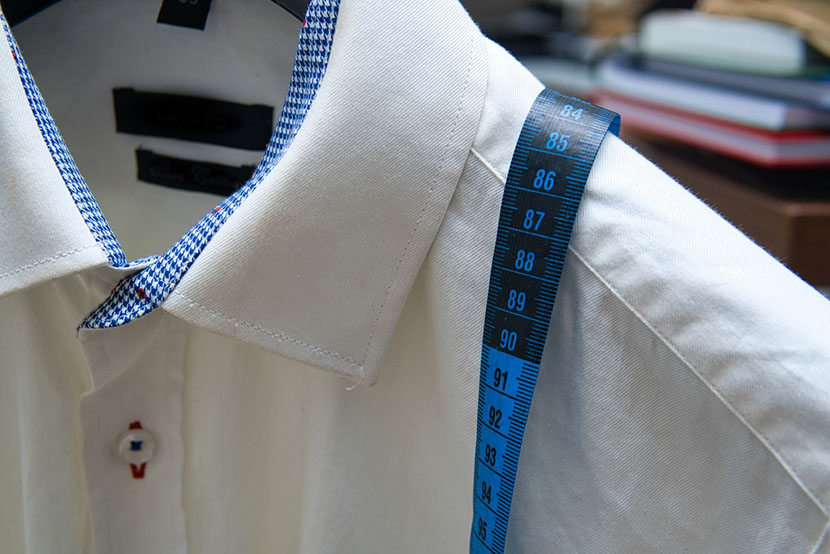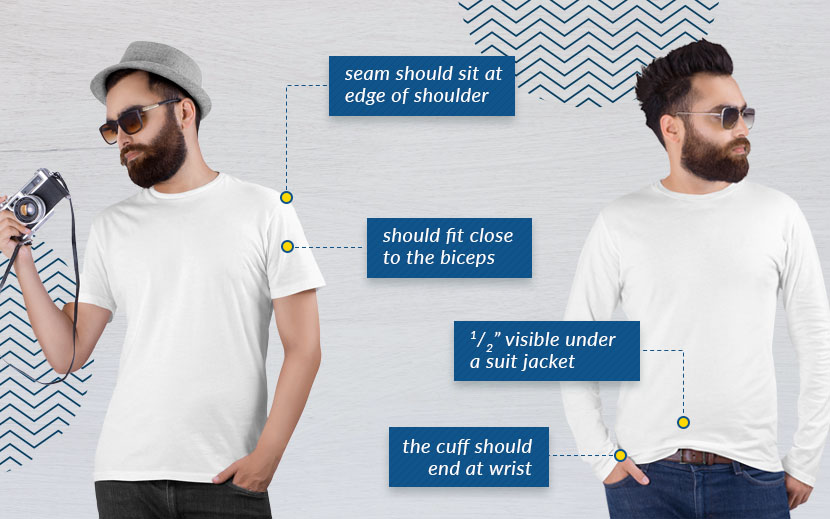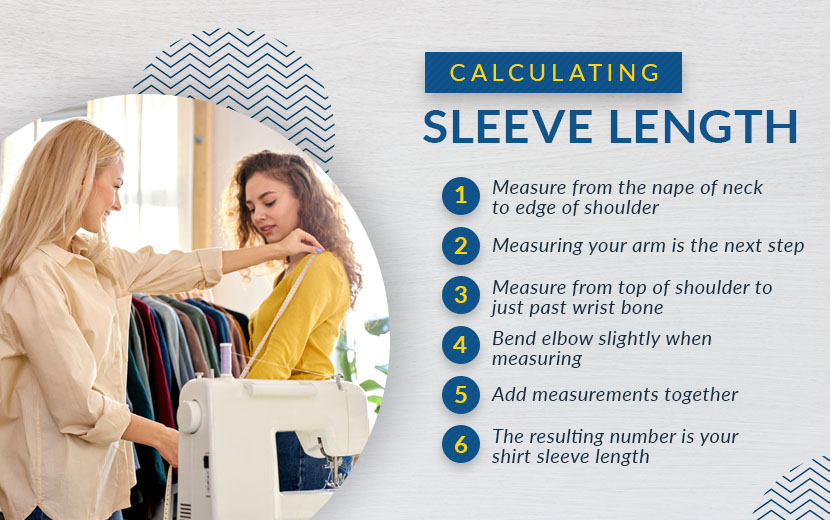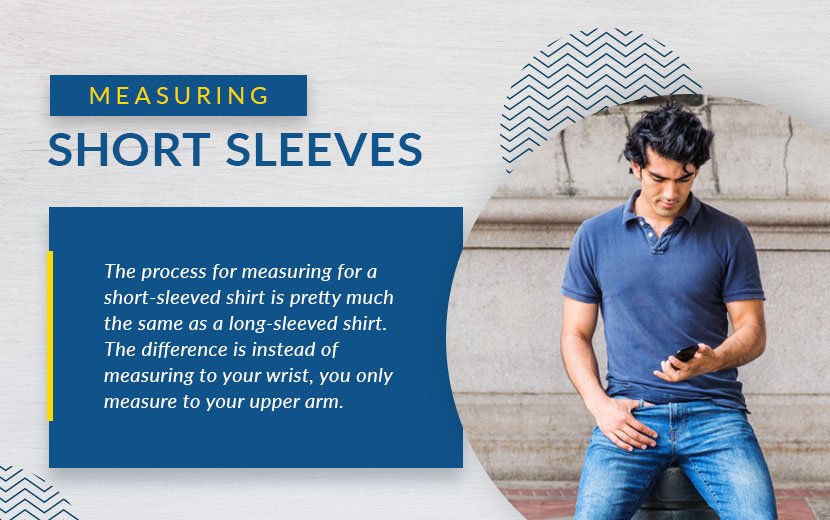How to Measure Sleeve Length for Short and Long Sleeves

Many years ago, knowing how to accurately measure sleeve length was an essential skill. Buying shirts today is as easy as going online, making a few clicks, and waiting a couple of days for your new apparel to show up in your mailbox.
It was not always that easy, though. Long before people could go online to shop for bulk t shirts and other garments, they had to make clothing themselves or order custom shirts from professional tailors. And since apparel wasn’t nearly as affordable or easy to obtain as it is now, they had to be certain of every measurement to ensure that what they made or ordered would fit properly.
While knowing how to measure sleeve length is not quite as necessary now as it was in years past, it is still a handy skill to have. Even if you typically only purchase ready-to-wear clothing, you never know when you might need to order a custom-made shirt from a tailor for a special event. Or, if you are a business owner, you could have a customer reach out to you regarding the length of your products’ short and long sleeves.
In any case, it never hurts to learn something new. If you have ever been curious about how to measure sleeve length for short and long sleeves, keep reading to learn more!
Shop The Adair Group for Blank T-Shirts and More!

General Information: Why Sleeve Length and Arm Length Aren’t the Same
Before we dive into the exact process of measuring sleeve length, it is essential to note that the length of your arm does not always equal the sleeve length that you need. Sleeves do not always end at the same point on one’s shoulders, and shoulder width varies from person to person. Someone with broad shoulders will need a much different sleeve length than someone with narrower shoulders, even if their arms are the exact same length.
In addition, the shape of the armhole plays a role in the overall size of the shoulder area of a shirt. This, of course, impacts sleeve length. Armhole shape and size vary depending on the style of the shirt, whether it is intended for men or women, and the brand/designer.
For these reasons, measuring yourself to determine what sleeve length you need requires more than just measuring the length of your arm.
How a Sleeve Should Fit

In a well-fitting shirt, the shoulder seam should sit comfortably at the edge of your shoulder at the point where it starts to slope downward. It should not sit on top of your shoulder or hang down to your upper arm.
For long-sleeved shirts, the cuff should end at your wrist. Half an inch of the shirt should be visible when worn under a suit jacket. There is a bit more flexibility for short-sleeved shirts. For men, they should fit close to the biceps and reach to just above the elbow. Since short-sleeved women’s shirts come in various styles, the exact length of the sleeves can vary significantly. There are cap sleeves that just cover the shoulders and sleeves that extend to the mid-bicep area.
As long as the shirt fits well and the sleeves are not overly loose or tight, you don’t need to be extremely concerned about their exact length.
Why You Might Need to Measure Sleeve Length
There are a few situations when knowing your sleeve length might be helpful. If you ever need to shop for a nice dress shirt, you will notice that the sizing often has two numbers separated by a slash. The first number indicates the size of the shirt’s opening, or your shirt collar size. The second number is the sleeve length. In order to choose the correct size, you will need to know your sleeve length. Otherwise, it’s a guessing game.
Knowing your sleeve length is helpful if you ever need to take a shirt to a tailor, too. While a tailor will likely measure you themself if you bring in a shirt with sleeves that need adjusting, being able to tell them your ideal sleeve length will make the process easier. Knowing your preferred sleeve length means the finished shirt will fit well and be comfortable.
If you own a business and resell bulk sweatshirts, t-shirts, or other tops, you may have customers reach out to you to inquire about sleeve length. While you likely cannot modify your merchandise to ensure it will fit each customer perfectly, knowing how to measure the sleeve length of a shirt will help you provide accurate, useful information to your customers.
You may also want to measure the length of the sleeves on shirts you already have and love so you can buy similar ones in the future. In this post, we will be discussing how to calculate your necessary sleeve length based on your arm length and how to measure sleeve length on a shirt you already have.

Determining Your Sleeve Length
If you need to determine your sleeve length when shopping for a dress shirt or having one custom-made by a tailor or designer, you will need a fabric tape measure. For the most accurate results, we recommend having someone help you. Calculating your sleeve length requires taking a few measurements, some of which are difficult to figure out on your own.
First, measure from the nape of your neck to the edge of your shoulder, where it begins to slope. At the nape of your neck, the end of the tape measure should be centered and in alignment with your spine. It’s much easier to measure this accurately if you have someone who can help you. If you’re having trouble, measure across your back from the edge of one shoulder to the other. Then, divide the measurement in half.
Measuring your arm is the next step. Hold one end of the tape measure at the top of your shoulder and measure to just past your wrist bone. Bend your elbow slightly when measuring. This will leave a bit of ease and ensure that the sleeve will not be too short. If you measure with your arm completely straight, the shirt you ultimately purchase or have made will likely have sleeves that are too short.
Once you have both measurements, add them together and round up to the nearest whole number. The resulting number is your shirt sleeve length. Whether you identify as a man or a woman, this technique is the most accurate way to measure your sleeve length.
How to Measure for a Short-Sleeved Shirt
While you are most likely to need to know sleeve length when you are shopping for long-sleeved shirts, there are times when knowing what short sleeve length you need can be helpful, too. Short-sleeved shirts are an ideal alternative to long sleeves on warm days. When they fit properly, they are suitable for a wide range of occasions. Unfortunately, lots of folks end up looking less than professional by wearing shirts with sleeves that are too long, short, loose, or tight.

The process for measuring for a short-sleeved shirt is pretty much the same as measuring for a long-sleeved shirt. However, the difference is that instead of measuring all the way to your wrist, you should only measure to where you want the hem of the sleeve to reach on your upper arm. For men, this usually means measuring to the center of your bicep or slightly below. The sleeve should not extend all the way to your elbow.
For women, measuring to the exact right point on the arm is not quite as important. For professional looks, sleeves that extend to roughly mid-bicep are the best option. But since sleeves come in more styles and lengths for women than men, determining the length that’s most comfortable for you is a good option, too. If you have a shirt that you love, measure based on where its hem reaches on your upper arm to determine your ideal length for short-sleeved shirts.
Measuring the Sleeve Length on Shirts You Already Have
When you need to measure the sleeves on a shirt you already have, start by laying it out on a flat surface and smoothing out any wrinkles. If you are measuring something bulky, like wholesale hoodies, you may want to iron the garments first to make sure they are completely flat. If you are measuring a shirt for yourself, make sure it is one that fits properly. The armhole seam should rest right where your shoulder begins to slope, not on top of your shoulder or hanging down to your upper arm.
Place one end of a fabric tape measure at the nape of the shirt’s neck. Make sure it is exactly in the center. Then, measure the distance to the seam where the body of the shirt meets the sleeve. Next, measure from that seam to the end of the sleeve. Finally, add that measurement and the first measurement together to determine the length of the sleeve.

Additional Tips on How to Measure Sleeve Length
As we previously mentioned, having someone help you is the best way to get an accurate measurement. Holding the measuring tape at the back of your neck and extending it along the length of your arm is tricky. Having a friend help you out is the best way to ensure accurate results with minimal frustration.
You may need to round your measurement up. If, for example, the sleeve length you come up with is 31.5 inches, consider rounding up to 32 inches. In addition to leaving a bit of ease to ensure the sleeve won’t be too short, this will make shopping easier. Different brands and retailers have different ways of advertising shirt sizes. Some offer half-inches, so you may see tags that say 14/31.5 (or something similar). Others label ranges, so you might see 14/31-32. Others only list a single whole number, so you may need to choose between 14/31 and 14/32. Whatever the case may be, rounding up is generally the best way to ensure a good fit.
When measuring, relax your body. If your attempt to measure when your back, neck, shoulders, and arms are tense, you will likely end up with sleeves that are too short. Maintaining a relaxed posture while measuring — and even bending your elbow a bit — ensures that your shirts will have plenty of room for movement.
Closing Thoughts
Whether you are trying to figure out your sleeve measurement so you can order a dress shirt that will fit flawlessly, you’re trying to find shirts that will fit like your current favorite, or you have a customer who has inquired about the length of your shirts’ sleeves, the tips and techniques above will help you obtain the information you need.
Measuring sleeve length is most common when shopping for dress shirts, but, even if you’re shopping for white t-shirts for tie dye, understanding sleeve length never hurts. This measurement can help you determine if a particular shirt is ideal for your next project.

We Have Wholesale Hoodies for Any Project
The Adair Group is the perfect place to find t-shirts, hoodies, and other blank apparel for any project. Our products come from leading manufacturers and are available at unbeatable prices. And when you order from us, you can rest assured knowing we stand behind the products we sell. Whether you need blank t-shirts to wear under your new dress shirts or are searching for wholesale clothing and accessories to customize and resell, we have you covered. Shop now for the wholesale blank apparel you need.
Image Credits
Steven Valentino/Shutterstock.com
Ploipiroon/Shutterstock.com
Pixpine Mockups/Shutterstock.com
Roman Chazov/Shutterstock.com
Alexander Image/Shutterstock.com
Minerva Studio/Shutterstock.com
katalinks/Shutterstock.com
Studio Romantic/Shutterstock.com
Kamil Zajaczkowski/Shutterstock.com


